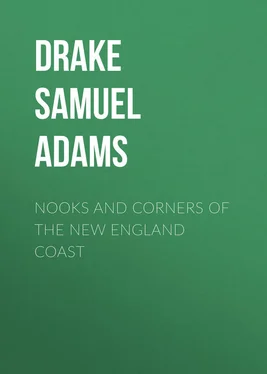Samuel Drake - Nooks and Corners of the New England Coast
Здесь есть возможность читать онлайн «Samuel Drake - Nooks and Corners of the New England Coast» — ознакомительный отрывок электронной книги совершенно бесплатно, а после прочтения отрывка купить полную версию. В некоторых случаях можно слушать аудио, скачать через торрент в формате fb2 и присутствует краткое содержание. Жанр: foreign_antique, foreign_prose, на английском языке. Описание произведения, (предисловие) а так же отзывы посетителей доступны на портале библиотеки ЛибКат.
- Название:Nooks and Corners of the New England Coast
- Автор:
- Жанр:
- Год:неизвестен
- ISBN:нет данных
- Рейтинг книги:3 / 5. Голосов: 1
-
Избранное:Добавить в избранное
- Отзывы:
-
Ваша оценка:
- 60
- 1
- 2
- 3
- 4
- 5
Nooks and Corners of the New England Coast: краткое содержание, описание и аннотация
Предлагаем к чтению аннотацию, описание, краткое содержание или предисловие (зависит от того, что написал сам автор книги «Nooks and Corners of the New England Coast»). Если вы не нашли необходимую информацию о книге — напишите в комментариях, мы постараемся отыскать её.
Nooks and Corners of the New England Coast — читать онлайн ознакомительный отрывок
Ниже представлен текст книги, разбитый по страницам. Система сохранения места последней прочитанной страницы, позволяет с удобством читать онлайн бесплатно книгу «Nooks and Corners of the New England Coast», без необходимости каждый раз заново искать на чём Вы остановились. Поставьте закладку, и сможете в любой момент перейти на страницу, на которой закончили чтение.
Интервал:
Закладка:
"Departing hence, we bare into that great gulf which Captain Gosnold overshot the year before." This could be no other than Massachusetts Bay, for Gosnold, according to Brereton, after leaving Savage Rock, shaped his course southward ("standing off southerly into the sea") the rest of that day and night (May 15th), and on the following morning found himself "embayed with a mighty headland," which was Cape Cod. Pring, on the contrary, steered into the bay, "coasting, and finding people on the north side thereof." If my conjecture be correct, he was the first English mariner in Boston Bay.
It is hardly possible that a navigator falling in with the New England coast in forty-three or forty-three and a half degrees, and steering south-west, should not recognize in Cape Ann one of its remarkable features, or pass it by unperceived in the night. He would have been likely to find Savage Rock and end his voyage at the same moment. Champlain and Smith are both in evidence. The former, who examined the coast minutely two years after Pring (June, 1605), has delineated "Cap des Isles" on his map of 1612, which accompanied the first edition of his voyages. The account he gives of its position is as clear as that of Archer is obscure. Says the Frenchman, in his own way:
"Mettant le cap au su pour nous esloigner afin de mouiller l'ancre, ayant fait environ deux lieux nous apperçumes un cap a la grande terre au su quart de suest de nous ou il pouvoit avoit six lieues; a l'est deux lieues apperçumes trois ou quatre isles assez hautes et a l'ouest un grand cu de sac."
Here are the bearings of Cape Ann, the Isles of Shoals, and of Ipswich Bay defined with precision. Champlain also puts the latitude of Kennebunk River at forty-three degrees twenty-five minutes, which shows Pring could hardly have explored to the eastward of Cape Elizabeth. Smith, in 1614, described Cape Ann and Cape Cod as the two great headlands of New England, giving to the former the name of Tragabigzanda; but Champlain had preceded him, as Gosnold had preceded Champlain. On the whole, Gosnold, Pring, and Champlain agree remarkably in their latitude and in their itinerary.
At Cape Neddoek I "put up," or rather was put up – an expression applied alike to man and beast in every public-house in New England – at the old Freeman Tavern, a famous stopping-place in by-gone years, when the mail-coach between Boston and Portland passed this way. Since I knew it the house had been brushed up with a coat of paint on the outside, the tall sign-post was gone, and nothing looked quite natural except the capacious red barn belonging to the hostel. The bar-room, however, was unchanged, and the aroma of old Santa Cruz still lingered there, though the pretty hostess assured me, on the word of a landlady, there was nothing in the house stronger than small beer. It was not so of yore, when all comers appeared to have taken the famous Highgate oath: "Never to drink small beer when you could get ale, unless you liked small beer best."
The evening tempted me to a stroll down to the harbor, to see the wood-coasters go out with the flood. Afterward I walked on the beach. The full moon shone out clear in the heavens, lighting up a radiant aisle incrusted with silver pavement on the still waters, broad at the shore, receding until lost in the deepening mystery of the farther sea. The ground-swell rose and fell with regular heaving, as of Old Ocean asleep. As a breaker wavered and toppled over, a bright gleam ran along its broken arch like the swift flashing of a train. Occasionally some craft crossed the moon's track, where it stood out for a moment with surprising distinctness, to be swallowed up an instant later in the surrounding blackness. Boon Island had unclosed its brilliant eye – its light in the window for the mariner. It had been a perfect day, but the night was enchanting.
CHAPTER IX.
AGAMENTICUS, THE ANCIENT CITY
"Land of the forest and the rock,
Of dark-blue lake and mighty river,
Of mountains reared aloft to mock
The storm's career, the lightning's shock —
My own green land forever."
Ho for Agamenticus! It is an old saying, attributed to the Iron Duke, that when a man wants to turn over it is time for him to turn out. As there are six good miles to get over to the mountain, and as many to return, I was early astir. The road is chiefly used by wood teams, and was well beaten to within half a mile of the hills. From thence it dwindled into a green lane, which in turn becomes a foot-path bordered by dense undergrowth. Agamenticus is not a high mountain, although so noted a landmark. There are in reality three summits of nearly equal altitude, ranging north-east and south-west, the westernmost being the highest. At the mountain's foot is a scattered hamlet of a few unthrifty-looking cabins, tenanted by wood-cutters, for, notwithstanding the axe has played sad havoc in the neighboring forests, there are still some clumps of tall pines there fit for the king's ships. You obtain your first glimpse of the hills when still two miles distant, the road then crossing the country for the rest of the way, with the mountain looming up before you.
Along shore, and in the country-side, the people call the mount indifferently "Eddymenticus" and "Head o' Menticus." Some, who had lived within a few miles of it since childhood, told me they had never had the curiosity to try the ascent. One man, who lived within half a mile of the base of the western hill, had never been on any of the others. The name is unmistakably of Indian origin. General Gookin, in his "Historical Collections of the Indians in New England," written in 1674, has the following in relation to the tribes inhabiting this region: "The Pawtuckett is the fifth and last great sachemship of Indians. Their country lieth north and north-east from the Massachusetts, whose dominion reacheth so far as the English jurisdiction, or colony of the Massachusetts, now doth extend, and had under them several other small sagamores, as the Pennacooks, Agawomes, Naamkeeks, Pascatawayes, Accomintas, and others." 68 68 "Massachusetts Historical Collections," 1792, vol. i.
The climb is only fatiguing; it is not at all difficult. The native forest has disappeared, but a new growth of deciduous trees, with a fair sprinkling of evergreens, is fast replacing it. In some places the slender stems of the birch or pine shoot up, as it were, out of the solid rock. Following the dry bed of a mountain torrent, and turning at every step to wonder and admire, in half an hour I stood on the top. The summit contains an acre or more of bare granite ledge, with tufts of wiry grass and clumps of tangled vines growing among the crevices. Some scattered blocks had been collected at the highest point, and a cairn built. I seated myself on the topmost stone of the monument.
A solitary mountain lifting itself above the surrounding country is always impressive. Agamenticus seems an outpost of the White Hills, left stranded here by the glacier, or upheaved by some tremendous throe. The day was not of the clearest, or, rather, the morning mists still hung in heavy folds about the ocean, making it look from my airy perch as if sky and sea had changed places. Capes and headlands were revealed in a striking and mystical way, as objects dimly seen through a veil. Large ships resembled toys, except that the blue space grasped by the eye was too vast for playthings. Cape Elizabeth northward and Cape Ann in the southern board stretched far out into the sea, as if seeking to draw tribute of all passing ships into the ports between. Here were the Isles of Shoals, lying in a heap together. That luminous, misty belt was Rye Beach. And here was the Piscataqua, and here Portsmouth, Kittery, and Old York, with all the sea-shore villages I had so lately traversed. As the sun rose higher, the murky curtain was rolled away, and the ocean appeared in its brightest azure.
Читать дальшеИнтервал:
Закладка:
Похожие книги на «Nooks and Corners of the New England Coast»
Представляем Вашему вниманию похожие книги на «Nooks and Corners of the New England Coast» списком для выбора. Мы отобрали схожую по названию и смыслу литературу в надежде предоставить читателям больше вариантов отыскать новые, интересные, ещё непрочитанные произведения.
Обсуждение, отзывы о книге «Nooks and Corners of the New England Coast» и просто собственные мнения читателей. Оставьте ваши комментарии, напишите, что Вы думаете о произведении, его смысле или главных героях. Укажите что конкретно понравилось, а что нет, и почему Вы так считаете.












